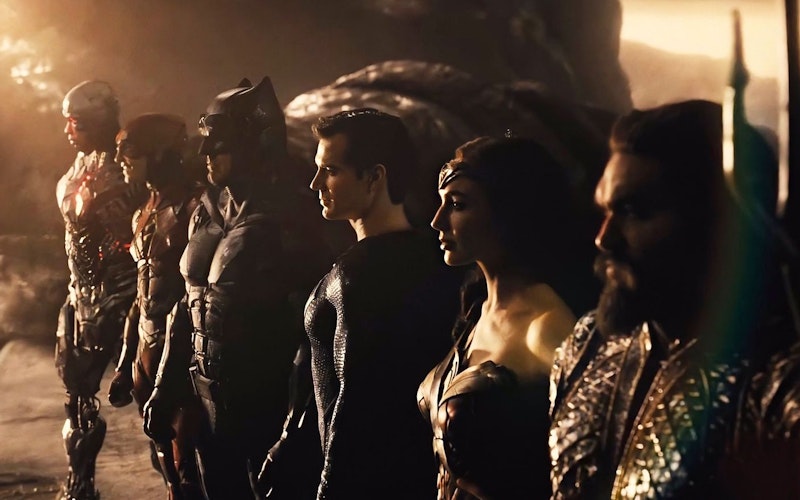
Movies
One Justice League, Many Members
Editor’s note: This post includes spoilers for Zack Snyder’s Justice League.
One of the many issues that plagued the theatrical release of 2017’s Justice League, which was partly directed by Zack Snyder and completed by Joss Whedon, was the characterization of its lead villain, Steppenwolf (Ciarán Hinds). Shallow in ambition, he made the worst of the Marvel Cinematic Universe’s villains seem Shakespearean. To add insult to injury, Hinds’s impassioned sincerity, which brought gravitas to the likes of Martin Scorsese’s Silence, was wasted on a villain who, despite his vociferous threats of world domination, never rose above angst masquerading as conviction.
Thankfully, Steppenwolf is one of the characters who most benefits from the lugubrious, four-hour Zack Snyder’s Justice League, the director’s new version of the film. (Snyder earlier left Justice League over creative differences with the studio and in the wake of a family tragedy.) At the very least, Steppenwolf looks like a villain worthy of fighting the world’s finest. He has all the makings of the devil, replete with spiked armor and long horns. The accompanying, black-and-white version of the film (dubbed Justice is Gray) leans into his demonic depiction even more. In a sequence where he lands in Wonder Woman’s home island of Themyscira via an interdimensional portal, the portal rips through the clouds as he descends, as though he is being banished from Heaven, Paradise Lost-style.
Additionally, Steppenwolf’s motivations for conquering Earth are fully fleshed out. While his actions remain the same between the theatrical film and Snyder’s cut—he wants to use alien pieces of technology called mother boxes to transform the Earth into a copy of his own fiery planet, Apokolips—here we learn that Steppenwolf is doing this because he has fallen out of the good graces of his master, Darkseid (Ray Porter). Previously forced to wander the universe alone, Steppenwolf accepts the task of conquering Earth gleefully, stating “He [Darkseid] will be pleased. He will see my worth again.” There’s a newfound narrative heft to Steppenwolf’s destruction and savagery; it becomes a plea to others and himself that he is more than the sum of his failures.
This extended backstory for Steppenwolf likewise elevates the central conflict at the heart of Justice League. Not only is the world attacked; so are the very tenets of true community. While describing Steppenwolf’s plan, Wonder Woman (Gal Gadot) fleshes out the implications, sharing that the synchronization of the mother boxes activates “the Unity,” which “cleanses a planet with fire, transforming it into a copy of the enemy’s world. All who live become servants of Darkseid, alive but drained of life.” For the forces of Apokolips, differences are anathemas to be smothered. For the conquered, there is no community to be invited into—just a kingdom to be ruled by.
For the forces of Apokolips, differences are anathemas to be smothered.
By contrast, the Justice League champions a far better community, one that celebrates rather than smothers difference and diversity, one where the call to die is rooted in the promise of a rebirth of something better. As the members of the League confront their own insecurities and kill their own idols, it is hard not to be reminded of Matthew 16, where Jesus states, “Whoever wants to be my disciple must deny themselves and take up their cross and follow me. For whoever wants to save their life will lose it, but whoever loses their life for me will find it.” From Batman (Ben Affleck) recruiting other members of the League, thereby combating the temptation of self-sufficiency, to Aquaman (Jason Momoa) and Wonder Woman setting aside a generations-old conflict between their people to work together, we see that before the Justice League can call themselves a league, they have to die to self first. Even Superman (Henry Cavill), despite being tempted to remain in the twin embrace of his mother Martha (Diane Lane) and love Lois (Amy Adams), flies back into the thick of battle, barely able to enjoy the first breaths of resurrection.
After they work together to defeat Steppenwolf, the League comes face to face with Darkseid’s forces via Boom Tube (think Zoom, but with a circular screen). Snyder paints a wonderful and triumphant contrast between the Apokolips forces and the League. While the former are uniformly black and gray (with occasional orange embellishments), the League is colorful, beaming, and wearing their idiosyncrasies on their sleeves. In these moments, Zack Snyder's Justice League depicts more closely a picture of the kingdom that Jesus invites all into: one of sacrifice, but also a celebration of difference, where we will be many members of one glorious body.
Topics: Movies